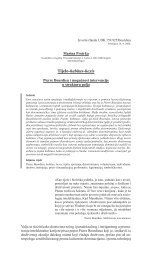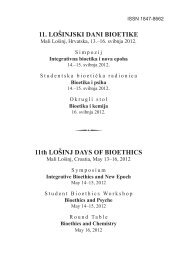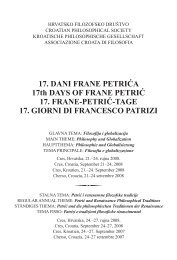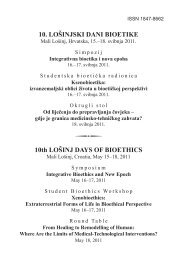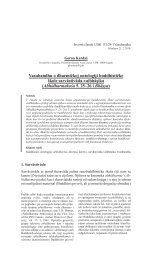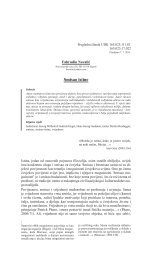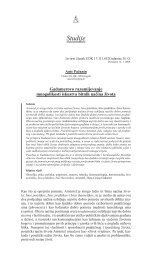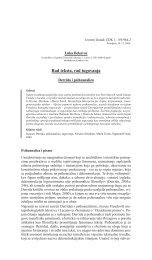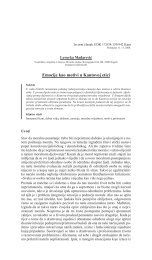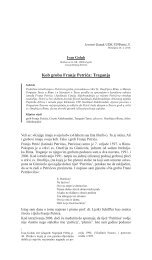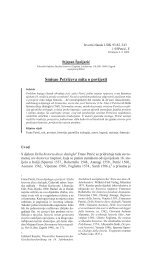Programska knjižica - Hrvatsko filozofsko društvo
Programska knjižica - Hrvatsko filozofsko društvo
Programska knjižica - Hrvatsko filozofsko društvo
Create successful ePaper yourself
Turn your PDF publications into a flip-book with our unique Google optimized e-Paper software.
of the paper deals with Ficino’s views as interpreted on the basis of his commentary<br />
on Plato’s Symposium, while the second discusses the specific characteristics<br />
of Ficino’s influence on the two Croatian philosophers, as well as the<br />
novelty that they introduce into the philosophy of love.<br />
Unlike Ficino, who comes forward with an ontological foundation of the<br />
concept of love, in which the elaboration of some aspects of the worldly manifestation<br />
of love logically follows from the fundamental determination of love<br />
as an omnipresent divine principle, whose oneness allows the divine and the<br />
human to unite, Petrić and Gučetić fail to follow the ontological foundation of<br />
love (with Petrić, however, this concept will appear in his mature work Nova<br />
de universis philosophia), the accent being shifted towards the presentation of<br />
the concrete embodiment of beauty as love object in the form of an individual,<br />
more precisely, of a female person. In doing so, the expression of admiration<br />
for the physical, moral and intellectual beauty of the female characters<br />
is in a specific kind of way an illustration of what is expounded in Ficino’s<br />
treatise on love. Characteristic of both Petrić’s and Gučetić’s approach are the<br />
most detailed descriptions of female physical beauty, though still within the<br />
frame of the Platonic understanding of the relationship between the spiritual<br />
and the physical—that is, physical beauty being primarily viewed as an image<br />
of spiritual beauty. Coupled with this topic is also an accentuated presence<br />
of the physiological interpretation of the physical manifestations of the love<br />
emotions, as well as astrological interpretation of man’s characteristics and his<br />
activities, predominantly in love, reflecting the Renaissance view of man the<br />
microcosm as an image of the macrocosm.<br />
It may be concluded that all the three philosophers encounter the same<br />
problems of principle nature—first of all, the problem of harmonisation of<br />
Neoplatonic with the Christian concept of love, but also with some of the open<br />
issues since Plato’s day, abruptly posed by Neoplatonism: with the question of<br />
the ὁρισμός of Plato’s philosophy and the possibility of its being overcome,<br />
and especially with the question of the relationship between love as emotion<br />
and love as universal principle, expressed in the dilemma love – demon or love<br />
– God.<br />
Central position of the love theme within Renaissance philosophy should<br />
be understood from the fact that the Renaissance Neoplatonism was an important<br />
segment of the Renaissance philosophy, and what essentially determines<br />
the Renaissance Neoplatonism is the syncretism which is witnessed mainly as<br />
a tendency towards that which unites. In accordance with this tendency, then<br />
the key position in the Neoplatonically conceived ontological system is awarded<br />
to the ‘middle,’ to the ‘in-between,’ that unites the extremes and which,<br />
because of this uniting function, necessarily has to be of dual meaning. Such a<br />
138



